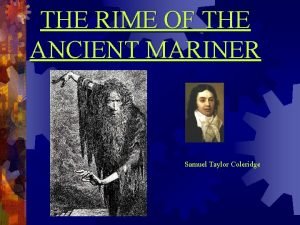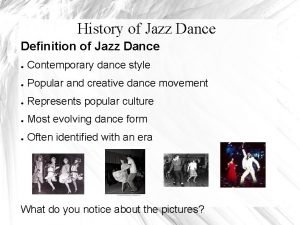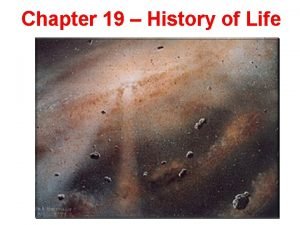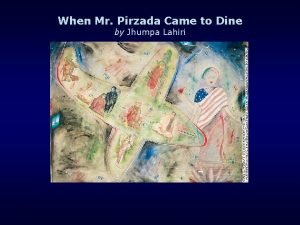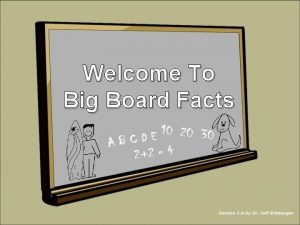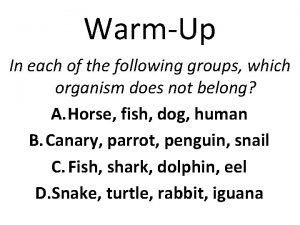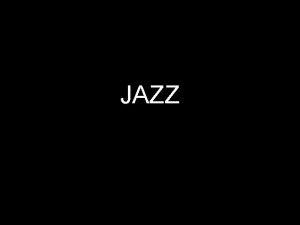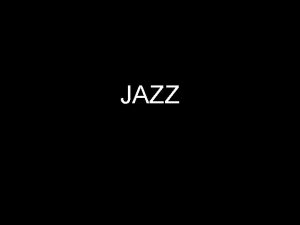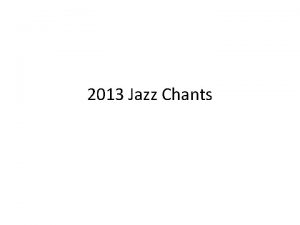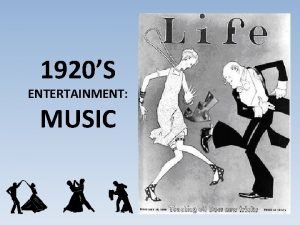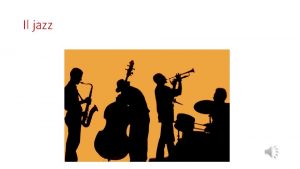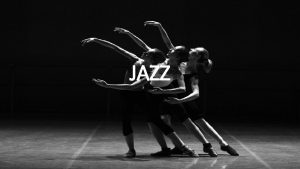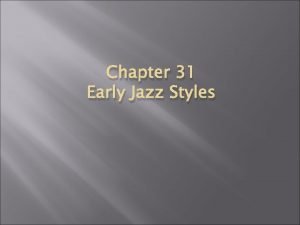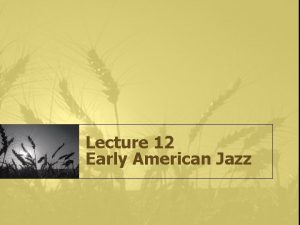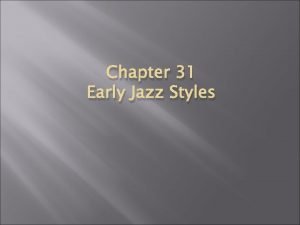Chicago Jazz Early History Chicago Jazz Jazz came
















- Slides: 16

Chicago Jazz: Early History

Chicago Jazz • Jazz came straight to Chicago's 12 th Street station via the Illinois Central Railroad, 200 miles east of where riverboats docked on the river. Part of a mass movement of African Americans from South to North -- what came to be called "The Great Migration" -- jazz musicians came north for the same reasons that other people did : failing crops and discrimination in the South; WWI demand for workers in Chicago factory jobs, paying decent money; and ads in the Chicago Defender holding out the hope of a better life up North.

Chicago Jazz • Between about 1916 and the end of the 1920's, at least 75, 000 Southern immigrants arrived on the South Side of Chicago -including musicians • newcomers immediately became part of an already flourishing African-American community on Chicago's South Side, the economic and entertainment district of which was known as "The Stroll. "

Chicago Jazz • It was the prospect of work in a community that could afford to pay to have a good time that drew musicians to Chicago, where they assembled in an unprecedented critical mass of jazz talent. • Chicago boasted major musical talent and famous venues well before Storyville closed; sheet music featuring the Pekin Theater at 2700 South State dates from 1904. According to the Chicago Defender, Vendome Orchestra leader Erskine Tate played his first violin recital in Chicago in 1910; Wilbur Sweatman was in Chicago playing clarinet in 1906; and Jelly Roll Morton led the band at the Richelieu starting in 1914 and also appeared at the De. Luxe and Elite #2 Cafes during 1914 -15. Various New Orleans musicians had already been north before 1917; Tom Brown's band in 1915 is widely regarded as the first band to come north.

Chicago Jazz • By the time Freddie Keppard, Sidney Bechet, Lee Collins, King Oliver, and other New Orleans musicians arrived in 1918 to rub musical shoulders with the local talent, the classic New Orleans style had already begun to change in deference to local tastes. Chicago venue owners, patrons, and musicians expected hard-driving, uptempo playing, and they expected elegantly turned out musicians in sophisticated surroundings -- places like the Grand Vendome Theaters, the Dreamland Ballroom, and clubs with posh names like Royal Gardens, Alvadere, Panama, and Sunset Cafe.

Chicago Jazz • The rich musical scene on The Stroll inspired musicians from all over town; it was not unusual for white musicians to head to the Stroll after their North side gigs to see what they could pick up. Among those appearing regularly for "music lessons" in South Side clubs were Jimmy Mc. Partland, Bud Freeman, Frank Teschemacher, Dave Tough, Gene Krupa, Muggsy Spanier, and Eddie Condon, who would collectively be credited with the creation of the "Chicago" jazz style of the 20's.

Leon “Bix” Beiderbecke (1903 -1931) • one of the great jazz musicians of the 1920's; he was also a child of the Jazz Age who drank himself to an early grave with illegal Prohibition liquor. His hard drinking and beautiful tone on the cornet made him a legend among musicians during his life. The legend of Bix grew even larger after he died.

Bix Beiderbecke • never learned to read music very well, but he had an amazing ear even as a child. His parents disapproved of his playing music and sent him to a military school outside of Chicago in 1921 • He was soon expelled for skipping class and became a full-time musician. In 1923 Beiderbecke joined the Wolverine Orchestra and recorded with them the following year. Bix was influenced a great deal by the Original Dixieland Jass Band, but soon surpassed their playing. In late 1924 Bix left the Wolverines to join Jean Goldkette's Orchestra, but his inability to read music eventually resulted in him losing the job.

Bix • In 1926 he spent some time with Frankie Trumbauer's Orchestra where he recorded his solo piano masterpiece "In a Mist". He also recorded some of his best work with Trumbauer and guitarist, Eddie Lang, under the name of Tram, Bix, and Eddie. Bix was able to bone up on his sight-reading enough to re-join Jean Goldkette's Orchestra briefly, before signing up as a soloist with Paul Whiteman's Orchestra was the most popular band of the 1920's and Bix enjoyed the prestige and money of playing with such a successful outfit, but it didn't stop his drinking.

Bix • In 1929 Bix's drinking began to catch up with him. He suffered from delirium tremens and he had a nervous breakdown while playing with the Paul Whiteman Orchestra, and was eventually sent back to his parents in Davenport, Iowa to recover. It should be noted that Paul Whiteman was very good to Bix during his struggles. He kept Bix on full pay long after his breakdown, and promised him that his chair was always open in the Whiteman Orchestra, but, Bix was never the same again, and never rejoined the band. He returned to New York in 1930 and made a few more records with his friend Hoagy Carmichael and under the name of Bix Beiderbecke and his Orchestra. But mainly, he holed himself up in a rooming house in Queens, New York where he drank a lot and worked on his beautiful solo piano pieces "Candlelight", "Flashes", and "In The Dark" (played here by Ralph Sutton; Bix never recorded them). He died at age 28 in 1931 during an alcoholic seizure. The official cause of death was lobar pneumonia and edema of the brain.

Hoagy Carmichael (1899 -1981) • Remembered today as one of America's great composers of popular songs. Several of his tunes, like "Star Dust" , "Georgia on My Mind" , "Up The Lazy River", "Lazybones", "Skylark" and "Heart and Soul" have become standards which are still widely performed.

Hoagy • While studying to be a lawyer at Indiana University, Hoagy wrote a couple tunes for a band called Curtis Hitch's Happy Harmonists. The songs were "Washboard Blues" and "Boneyard Shuffle" and they were recorded in 1924 for Gennett records with Carmichael on piano. Through his association with this band he meet Bix Beiderbecke

Hoagy • Music publisher Irving Mills heard the Wolverine's record and wrote Carmichael asking if his company could publish the song, to which Hoagy agreed. Carmichael himself led several other sessions at Gennett, where he recorded the first version of "Stardust" in 1927

Hoagy • But Carmichael took a job in Florida as a law clerk after graduating. While there, he unexpectedly heard a recording of his song, "Washboard Blues", by Red Nichols and his Five Pennies. He had been unaware that the song had been rerecorded. It was then that he decided to abandon law and become a musician. Carmichael returned to Indiana and resumed his music career. Several of his friends, including Bix, were playing in Paul Whiteman's Orchestra by this time. Whiteman was familiar with some of Carmichael's Gennett recordings and also went on to record Hoagy's "Washboard Blues" in 1927.

Hoagy • Hoagy sings and plays piano on the track and it holds up as one of the Whiteman Orchestra's best performances. In 1930 Isham Jones and his Orchestra had a huge hit with a ballad version of Stardust. By 1935 Hoagy was working in Hollywood as a songwriter and he also became a character actor, appearing in over twenty films throughout his career. In 1941 he had a number one hit with the song "Huggin' & Chalkin".

Hoagy • In 1951 he won an Oscar for his song "In the Cool, Cool of the Evening" that was performed by Bing Crosby in Paramount's "Here Comes the Groom". In 1956 Carmichael recorded an excellent LP called "Hoagy Sings Carmichael" on the Pacific Jazz Label. The record placed Hoagy back into a no-nonsense Jazz setting for the first time in years and featured several West Coast Jazz musicians including Art Pepper on alto saxophone. In 1959 and 1960 he was a regular on the western TV series Laramie. In the 1960 s he composed two orchestral works, "Brown County In Autumn" and "Johnny Appleseed" which were unsuccessful. He never resumed his songwriting career after the failure of these two works.
 Instead of the cross the albatross alliteration
Instead of the cross the albatross alliteration Early cpr and early defibrillation can: *
Early cpr and early defibrillation can: * Jazz dance history
Jazz dance history Definition of jazz dance
Definition of jazz dance Section 17-2 earth's early history
Section 17-2 earth's early history 17-2 earth's early history
17-2 earth's early history Section 17-2 earth's early history
Section 17-2 earth's early history Floral
Floral Early beginnings of tourism
Early beginnings of tourism Floral design history
Floral design history What do historians call the early period of human history
What do historians call the early period of human history Also history physical
Also history physical Where does the word volcano come from?
Where does the word volcano come from? When mr. pirzada came to dine themes
When mr. pirzada came to dine themes What came first the chicken or the egg
What came first the chicken or the egg King phillip came over for good soup
King phillip came over for good soup Kpcofgs
Kpcofgs
